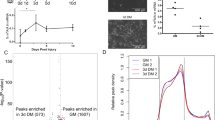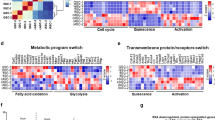Abstract
Satellite cells purified from adult skeletal muscle can participate extensively in muscle regeneration and can also re-populate the satellite cell pool, suggesting that they have direct therapeutic potential for treating degenerative muscle diseases1,2. The paired-box transcription factor Pax7 is required for satellite cells to generate committed myogenic progenitors3. In this study we undertook a multi-level approach to define the role of Pax7 in satellite cell function. Using comparative microarray analysis, we identified several novel and strongly regulated targets; in particular, we identified Myf5 as a gene whose expression was regulated by Pax7. Using siRNA, fluorescence-activated cell sorting (FACS) and chromatin immunoprecipitation (ChIP) studies we confirmed that Myf5 is directly regulated by Pax7 in myoblasts derived from satellite cells. Tandem affinity purification (TAP) and mass spectrometry were used to purify Pax7 together with its co-factors. This revealed that Pax7 associates with the Wdr5–Ash2L–MLL2 histone methyltransferase (HMT) complex that directs methylation of histone H3 lysine 4 (H3K4, refs 4–10). Binding of the Pax7–HMT complex to Myf5 resulted in H3K4 tri-methylation of surrounding chromatin. Thus, Pax7 induces chromatin modifications that stimulate transcriptional activation of target genes to regulate entry into the myogenic developmental programme.
This is a preview of subscription content, access via your institution
Access options
Subscribe to this journal
Receive 12 print issues and online access
$209.00 per year
only $17.42 per issue
Buy this article
- Purchase on Springer Link
- Instant access to full article PDF
Prices may be subject to local taxes which are calculated during checkout




Similar content being viewed by others
References
Kuang, S., Kuroda, K., Le Grand, F. & Rudnicki, M. A. Asymmetric self-renewal and commitment of satellite stem cells in muscle. Cell 129, 999–1010 (2007).
Montarras, D. et al. Direct isolation of satellite cells for skeletal muscle regeneration. Science 309, 2064–2067 (2005).
Seale, P. et al. Pax7 is required for the specification of myogenic satellite cells. Cell 102, 777–786. (2000).
Steward, M. M. et al. Molecular regulation of H3K4 trimethylation by ASH2L, a shared subunit of MLL complexes. Nature Struct. Mol. Biol. 13, 852–854 (2006).
Wysocka, J., Myers, M. P., Laherty, C. D., Eisenman, R. N. & Herr, W. Human Sin3 deacetylase and trithorax-related Set1/Ash2 histone H3-K4 methyltransferase are tethered together selectively by the cell-proliferation factor HCF-1. Genes Dev. 17, 896–911 (2003).
Roguev, A. et al. The Saccharomyces cerevisiae Set1 complex includes an Ash2 homologue and methylates histone 3 lysine 4. Embo J. 20, 7137–7148 (2001).
Yokoyama, A. et al. Leukemia proto-oncoprotein MLL forms a SET1-like histone methyltransferase complex with menin to regulate Hox gene expression. Mol. Cell. Biol. 24, 5639–5649 (2004).
Milne, T. A. et al. MLL associates specifically with a subset of transcriptionally active target genes. Proc. Natl Acad. Sci. USA 102, 14765–14770 (2005).
Milne, T. A. et al. Menin and MLL cooperatively regulate expression of cyclin-dependent kinase inhibitors. Proc. Natl Acad. Sci. USA 102, 749–754 (2005).
Hughes, C. M. et al. Menin associates with a trithorax family histone methyltransferase complex and with the hoxc8 locus. Mol. Cell 13, 587–597 (2004).
Relaix, F., Rocancourt, D., Mansouri, A. & Buckingham, M. A Pax3/Pax7-dependent population of skeletal muscle progenitor cells. Nature 435, 948–953 (2005).
Gros, J., Manceau, M., Thome, V. & Marcelle, C. A common somitic origin for embryonic muscle progenitors and satellite cells. Nature 435, 954–958 (2005).
Kassar-Duchossoy, L. et al. Pax3/Pax7 mark a novel population of primitive myogenic cells during development. Genes Dev. 19, 1426–1431 (2005).
Relaix, F. et al. Pax3 and Pax7 have distinct and overlapping functions in adult muscle progenitor cells. J. Cell Biol. 172, 91–102 (2006).
Kuang, S., Charge, S. B., Seale, P., Huh, M. & Rudnicki, M. A. Distinct roles for Pax7 and Pax3 in adult regenerative myogenesis. J. Cell Biol. 172, 103–113 (2006).
Bennicelli, J. L., Advani, S., Schafer, B. W. & Barr, F. G. PAX3 and PAX7 exhibit conserved cis-acting transcription repression domains and utilize a common gain of function mechanism in alveolar rhabdomyosarcoma. Oncogene 18, 4348–4356. (1999).
Zammit, P. S. et al. Muscle satellite cells adopt divergent fates: a mechanism for self-renewal? J. Cell Biol. 166, 347–357 (2004).
Berkes, C. A. & Tapscott, S. J. MyoD and the transcriptional control of myogenesis. Semin. Cell Dev. Biol. 16, 585–595 (2005).
Ishibashi, J., Perry, R. L., Asakura, A. & Rudnicki, M. A. MyoD induces myogenic differentiation through cooperation of its NH2- and COOH-terminal regions. J. Cell Biol. 171, 471–482 (2005).
Sabourin, L. A., Girgis-Gabardo, A., Seale, P., Asakura, A. & Rudnicki, M. A. Reduced differentiation potential of primary MyoD−/− myogenic cells derived from adult skeletal muscle. J. Cell. Biol. 144, 631–643 (1999).
Dou, Y. et al. Regulation of MLL1 H3K4 methyltransferase activity by its core components. Nature Struct. Mol. Biol. 13, 713–719 (2006).
Ruthenburg, A. J. et al. Histone H3 recognition and presentation by the WDR5 module of the MLL1 complex. Nature Struct. Mol. Biol. 13, 704–712 (2006).
Couture, J. F., Collazo, E. & Trievel, R. C. Molecular recognition of histone H3 by the WD40 protein WDR5. Nature Struct. Mol. Biol. 13, 698–703 (2006).
Han, Z. et al. Structural basis for the specific recognition of methylated histone H3 lysine 4 by the WD-40 protein WDR5. Mol. Cell 22, 137–144 (2006).
Wysocka, J. et al. WDR5 associates with histone H3 methylated at K4 and is essential for H3 K4 methylation and vertebrate development. Cell 121, 859–872 (2005).
Martin, C. & Zhang, Y. The diverse functions of histone lysine methylation. Nature Rev. Mol. Cell Biol. 6, 838–849 (2005).
Bernstein, B. E. et al. Methylation of histone H3 Lys 4 in coding regions of active genes. Proc. Natl Acad. Sci. USA 99, 8695–700 (2002).
Liang, G. et al. Distinct localization of histone H3 acetylation and H3-K4 methylation to the transcription start sites in the human genome. Proc. Natl Acad. Sci. USA 101, 7357–7362 (2004).
Santos-Rosa, H. et al. Active genes are tri-methylated at K4 of histone H3. Nature 419, 407–411 (2002).
Bernstein, B. E. et al. Genomic maps and comparative analysis of histone modifications in human and mouse. Cell 120, 169–181 (2005).
Rea, S. et al. Regulation of chromatin structure by site-specific histone H3 methyltransferases. Nature 406, 593–599 (2000).
Bajard, L. et al. A novel genetic hierarchy functions during hypaxial myogenesis: Pax3 directly activates Myf5 in muscle progenitor cells in the limb. Genes Dev. 20, 2450–2464 (2006).
Buchberger, A., Freitag, D. & Arnold, H. H. A homeo-paired domain-binding motif directs Myf5 expression in progenitor cells of limb muscle. Development 134, 1171–1180 (2007).
Shevchenko, A., Wilm, M., Vorm, O. & Mann, M. Mass spectrometric sequencing ofproteins silver-stained polyacrylamide gels. Anal. Chem. 68, 850–858 (1996).
Acknowledgements
The authors are indebted to Doug Borris and Murray Smith for mass spectrometry analysis; Jeff Baker and Joyce Li for technical assistance; and to Marjorie Brand, Jennifer McCann, Mark Gillespie and Dave Picketts for critical input. This work was supported by grants to M.A.R. from the National Institutes of Health, the HHMI, the Canadian Institutes of Health Research, the Muscular Dystrophy Association and the CRC Program.
Author information
Authors and Affiliations
Corresponding author
Supplementary information
Rights and permissions
About this article
Cite this article
McKinnell, I., Ishibashi, J., Le Grand, F. et al. Pax7 activates myogenic genes by recruitment of a histone methyltransferase complex. Nat Cell Biol 10, 77–84 (2008). https://doi.org/10.1038/ncb1671
Received:
Accepted:
Published:
Issue Date:
DOI: https://doi.org/10.1038/ncb1671
This article is cited by
-
The regenerative potential of Pax3/Pax7 on skeletal muscle injury
Journal of Genetic Engineering and Biotechnology (2022)
-
Control of satellite cell function in muscle regeneration and its disruption in ageing
Nature Reviews Molecular Cell Biology (2022)
-
MyoD is a 3D genome structure organizer for muscle cell identity
Nature Communications (2022)
-
Multiple Isoforms of Olive Flounder (Paralichthys olivaceus) Pax3a and Pax3b Display Differential Regulations on Myogenic Differentiation
Journal of Ocean University of China (2022)
-
Epigenetic regulation of satellite cell fate during skeletal muscle regeneration
Skeletal Muscle (2021)



